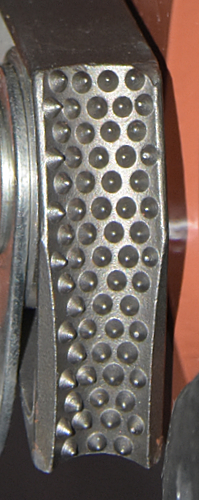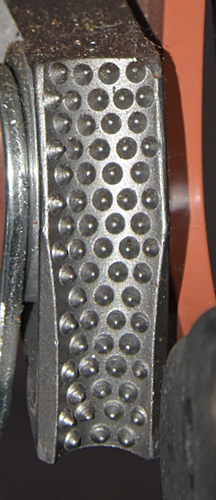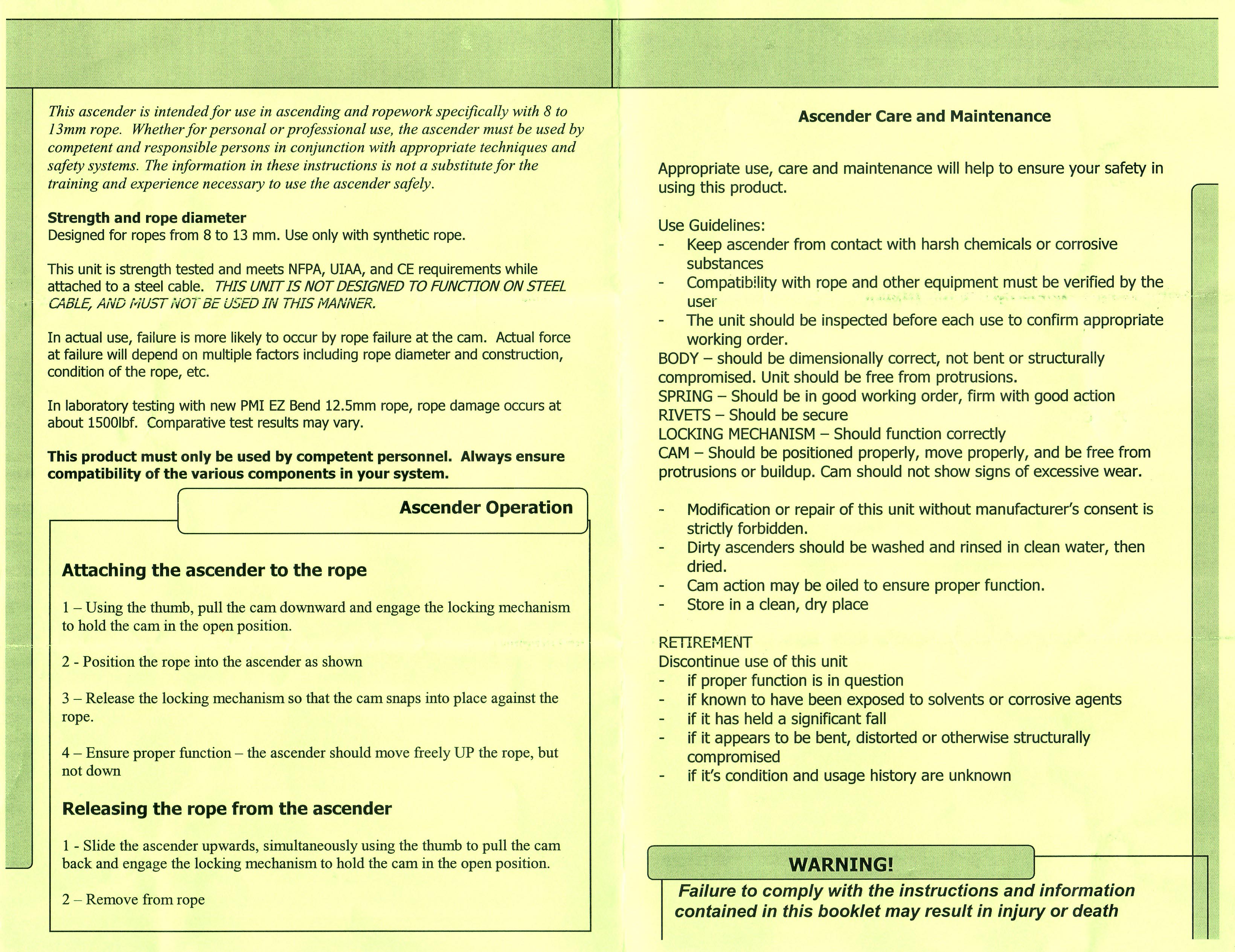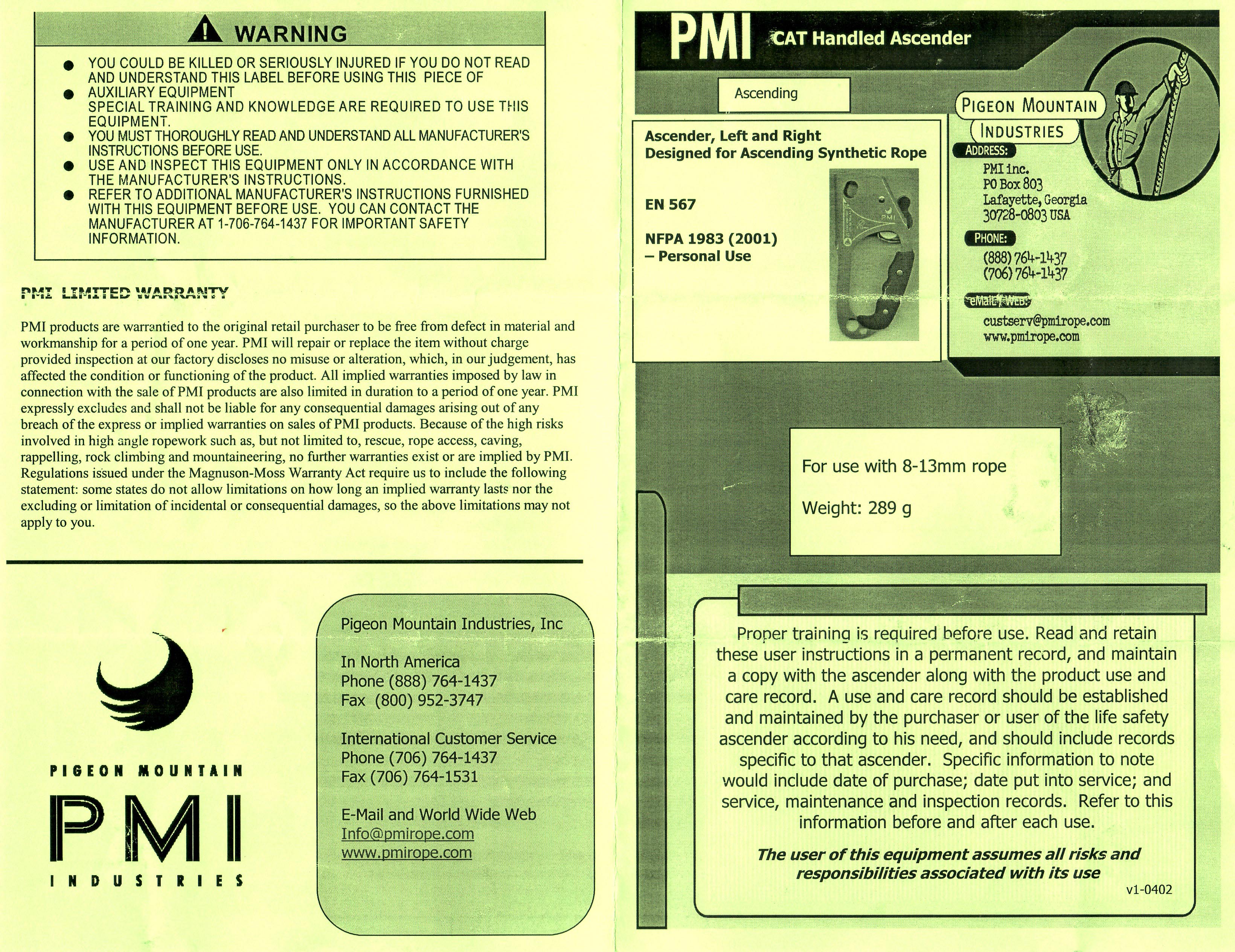Overview
[ Top
| Version B
| Return to H.E.C. Ascenders
]
Version A
(#2310)
Technical Details
 I acquired this ascender in 2017 as part of Bob Thrun’s collection.
I acquired this ascender in 2017 as part of Bob Thrun’s collection.
The cam safety on this version is 1.3 mm. thick compared to 2.2 mm. on Version B.
The front of the ascenders is stamped "M533." The back is printed with
a design, a "feather" icon, "PMI," "WALES,"
an arrow with "UP," "Ø 8-13mm," "CE0086
EN 567," "NFPA 1983 (2001)," and the letter "L"
inside a circle.
I assume that this is the older version, based mainly on the number stamped on the front.
[ Top
| Version A
| Return to H.E.C. Ascenders
]
Version B
(#164, 2163)
Technical Details
I acquired this pair of ascenders from Inner Mountain Outfitters
in March 2003. I acquired another pair in 2017 as part of Bob Thrun’s collection.
 The shell is a tall irregular shaped stamping made from 4.2 mm. aluminum alloy sheet metal. A rope channel is formed in the
upper portion of one side and a smaller cam channel lies opposite
the first. A hole drilled through both sides of the cam channel
accepts a 6 mm. rivet. The cam and cam spring are mounted on this
rivet, along with a flat washer on each side of the cam. The handle
below the cam has a soft "rubbery" two-piece hand grip
riveted into place. The hand grip has four shallow finger grooves.
A 15.8 mm. sling attachment hole is punched below the handle opening,
and a 9 mm. hole is punched below and outside the first. A 14.8
by 21.1 mm. oval hole through both sides of the rope channel provide
an attachment point just above the cam. There is no cam stop.
The shell is a tall irregular shaped stamping made from 4.2 mm. aluminum alloy sheet metal. A rope channel is formed in the
upper portion of one side and a smaller cam channel lies opposite
the first. A hole drilled through both sides of the cam channel
accepts a 6 mm. rivet. The cam and cam spring are mounted on this
rivet, along with a flat washer on each side of the cam. The handle
below the cam has a soft "rubbery" two-piece hand grip
riveted into place. The hand grip has four shallow finger grooves.
A 15.8 mm. sling attachment hole is punched below the handle opening,
and a 9 mm. hole is punched below and outside the first. A 14.8
by 21.1 mm. oval hole through both sides of the rope channel provide
an attachment point just above the cam. There is no cam stop.
The cam is a plated skeletonized steel casting. The cam has
number of small conical teeth, all of which have their axes approximately
in line with the corresponding radius from the cam pivot. The
tooth pattern is (4.5)^3(4.3)^3. A spring-loaded manual safety
bar is bolted to a cylindrical cam inset. The normal action of
the spring holds the safety against the cam. When the cam is opened,
the shell interferes with the safety bar, thus preventing opening
the cam. If the safety bar is moved away from the cam (opposing
the spring), it will clear the shell and the cam will open. At
full open the safety can be released and the spring will hold
the safety against the back of the shell. This provides a means
of locking the cam open. A pin on the safety assists in operating
the safety mechanism.
The front of the left and right ascender obtained from Inner Mountain Outfitters are stamped "M7655"
and "M8066," respectively. The ones from Bob Thrun’s collection are stamped "M7494"
and "M8540," respectively. The back is printed with
a design, a "feather" icon, "PMI," "WALES,"
an arrow with "UP," "Ø 8-13mm," "CE0086
EN 567," "NFPA 1983 (2001)," and the letter "L"
inside a circle.
The Cat is essentially the same ascender as the Hugh
Banner, except that the bolt attaching the safety to the cam
is much smaller. The Cat is also about 14 grams heavier - which
I cannot explain.
They are well-made ascenders and perform much like the Petzl Ascension. All sharp edges have been
removed. The attachment points are simply holes in the shell, and
although rounded they should have been beveled more; even so,
I would consider their small radius too sharp for directly attaching
sling ropes. They are probably acceptably rounded for webbing
(or could be made so), but considering the proximity of the attachment
points to the main rope, I would recommend using a small maillon
for most attachments in order to reduce the risk of sling abrasion.
The lower attachment hole could theoretically have the same safety
problems as the one on Clog Version A.
The upper rope attachment hole is located very close to the main
rope. A carabiner through the upper attachment hole will probably
drag on the main line. Note that such a carabiner will prevent
putting the ascender on or off rope, so one’s climbing system
must be designed accordingly.
The safety is one of the easiest to use with one hand. The
finger ribs are not comfortable for me because the ribs are spaced
poorly for my hand. In addition, the handle is too "square" for my taste. A file
can address both objections. The cam is very well made, but
the teeth are blunt, much like a worn Jumar’s.
This ascender has the same pit lip disadvantage as the Clog and other stamped frame ascenders.
The shell is thicker that the one on the Camp
Pilot, Kong-Bonaiti, and Petzl
Ascension but it isn't reinforced as it is on those.
I'm not sure the extra holes are needed at the base. Except for the Petzl Pompe, I've never found a real need for a second hole. Some people like them, and I might find them more appealing if they were large enough for a standard carabiner to fit through.
If you are looking for a stamped-frame handled ascender, the
Cat is yet another a reasonable choice to consider - just take
a file to the handle.
[ Top
| Version A
| Version B
]




